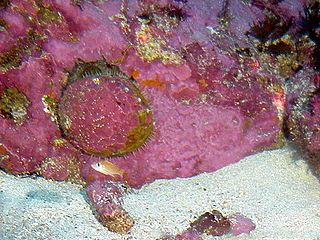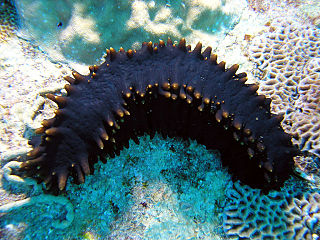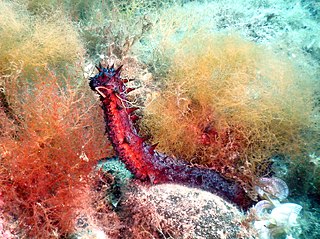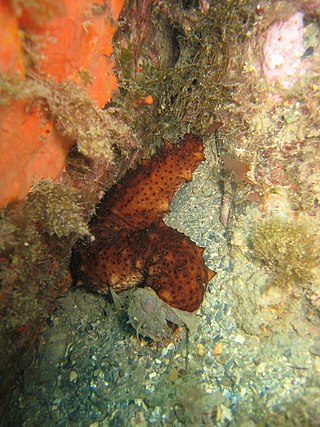
Sea cucumbers are echinoderms from the class Holothuroidea. They are marine animals with a leathery skin and an elongated body containing a single, branched gonad. They are found on the sea floor worldwide. The number of known holothurian species worldwide is about 1,786, with the greatest number being in the Asia–Pacific region. Many of these are gathered for human consumption, and some species are cultivated in aquaculture systems. The harvested product is variously referred to as trepang, namako, bêche-de-mer, or balate. Sea cucumbers serve a useful role in the marine ecosystem as they help recycle nutrients, breaking down detritus and other organic matter, after which bacteria can continue the decomposition process.

The California sea cucumber, also known as the giant California sea cucumber, is a sea cucumber that can be found from the Gulf of Alaska to Baja California. It is found from the low intertidal zone to a depth of 250 m (820 ft). They are most abundant in areas with moderate current with cobbles, boulders or bedrock. They are artisanally fished.

The school shark is a houndshark of the family Triakidae, and the only member of the genus Galeorhinus. Common names also include tope, tope shark, snapper shark, and soupfin shark. It is found worldwide in temperate seas at depths down to about 800 m (2,600 ft). It can grow to nearly 2 m long. It feeds both in midwater and near the seabed, and its reproduction is ovoviviparous. This shark is caught in fisheries for its flesh, its fins, and its liver, which has a very high vitamin A content. The IUCN has classified this species as critically endangered in its Red List of Threatened Species.

Isostichopus badionotus, also known as the chocolate chip cucumber or the cookie dough sea cucumber, is a species of sea cucumber in the family Stichopodidae. This common species is found in warm parts of the Atlantic Ocean.

The white abalone, scientific name Haliotis sorenseni, is a species of large sea snail, a marine gastropod mollusk in the family Haliotidae, the abalones.

Cucumaria miniata is a species of sea cucumber. It is commonly known as the orange sea cucumber or red sea cucumber due to its striking color. This northeast Pacific species is often found wedged in between rocks or crevices at the coast or on docks and can generally be identified by its orange bushy tentacles protruding above the substrate.
The worm pearlfish is an eel-like fish in the family Carapidae.

Stichopus chloronotus is a species of sea cucumber. Common names include the greenfish sea cucumber, the spiky sea cucumber and the black knobby sea cucumber. It is native to the Indo-Pacific region. It has a wide range and is abundant and the IUCN lists it as being of "Least Concern".

Holothuria scabra, or sandfish, is a species of sea cucumber in the family Holothuriidae. It was placed in the subgenus Metriatyla by Rowe in 1969 and is the type species of the subgenus. Sandfish are harvested and processed into "beche-de-mer" and eaten in China and other Pacific coastal communities.

Holothuria tubulosa, the cotton-spinner or tubular sea cucumber, is a species of sea cucumber in the family Holothuriidae. It is the type species of the genus Holothuria and is placed in the subgenus Holothuria, making its full name Holothuria (Holothuria) tubulosa.

Bohadschia argus, the leopard sea cucumber, leopardfish, or tigerfish, is a species of sea cucumber in the family Holothuriidae. It is native to the tropical Western Indo-Pacific region.

Apostichopus japonicus is a species of sea cucumber in the family Stichopodidae. It is found in shallow temperate waters along the coasts of south east Asia and is commonly known as the Japanese spiky sea cucumber or the Japanese sea cucumber.

Holothuria leucospilota, commonly known as the black sea cucumber or black tarzan, is a species of marine invertebrate in the family Holothuriidae. It is placed in the subgenus Mertensiothuria making its full scientific name Holothuria (Mertensiothuria) leucospilota. It is the type species of the subgenus and is found on the seabed in shallow water in the Indo-Pacific.

Holothuria edulis, commonly known as the edible sea cucumber or the pink and black sea cucumber, is a species of echinoderm in the family Holothuriidae. It was placed in the subgenus Halodeima by Pearson in 1914, making its full scientific name Holothuria (Halodeima) edulis. It is found in shallow water in the tropical Indo-Pacific Ocean.
Psolus chitonoides, also known as the slipper sea cucumber, armoured sea cucumber, creeping armoured sea cucumber, or creeping pedal sea cucumber, is a species of sea cucumber in the family Psolidae. It is found in shallow water on the western coast of North America. The scientific name "chitonoides" means resembling a chiton.

Actinopyga echinites, commonly known as the brownfish or deep water redfish, is a species of sea cucumber in the family Holothuriidae. It is native to the tropical Indo-Pacific region and is harvested for food.

Holothuria fuscocinerea, the ashy pink sea cucumber, is a species of sea cucumber in the family Holothuriidae. It is placed in the subgenus Stauropora, making its full name Holothuria (Stauropora) fuscocinerea. It is native to shallow water in the tropical and sub-tropical Indo-Pacific.

Holothuria fuscopunctata, the elephant trunkfish, is a species of sea cucumber in the family Holothuriidae native to shallow water in the tropical Indo-Pacific. It is placed in the subgenus Microthele, making its full name Holothuria (Microthele) fuscopunctata.
Actinopyga agassizii, commonly known as the five-toothed sea cucumber or West Indian sea cucumber, is a species of sea cucumber in the family Holothuriidae. It was first described by German zoologist Emil Selenka in 1867. It is native to the Western Atlantic region, including the Gulf of Mexico and the Caribbean Sea, and is harvested for food.

Holothuria stellati, also known as the Brown sea cucumber,is a species of sea cucumber in the family Holothuriidae. First described by Delle Chiaje in 1824. There are two accepted subspecies, Holothuria stellatidakarensis and Holothuria stellati mammata, though there is still debate on whether or not they are separate species.

















